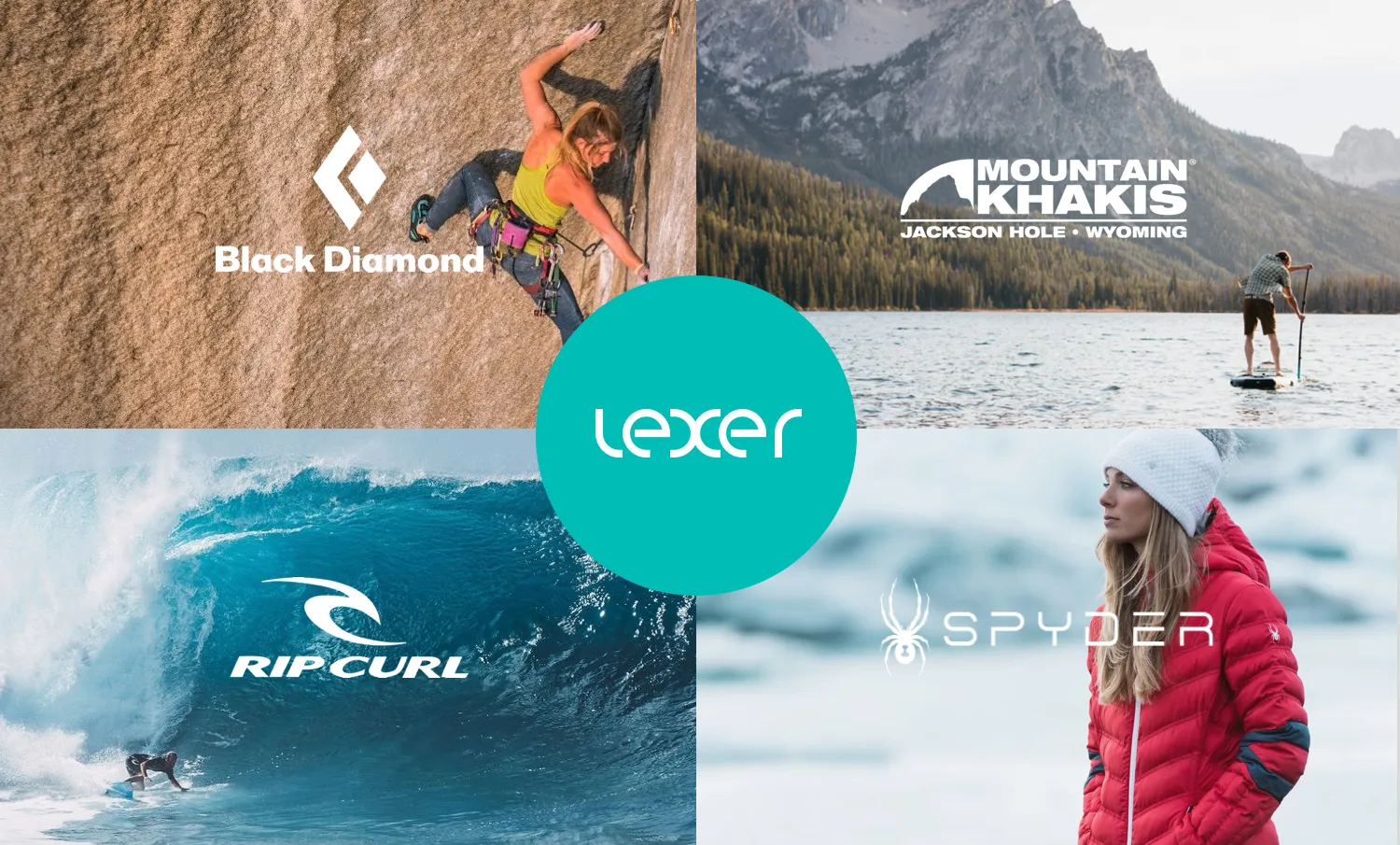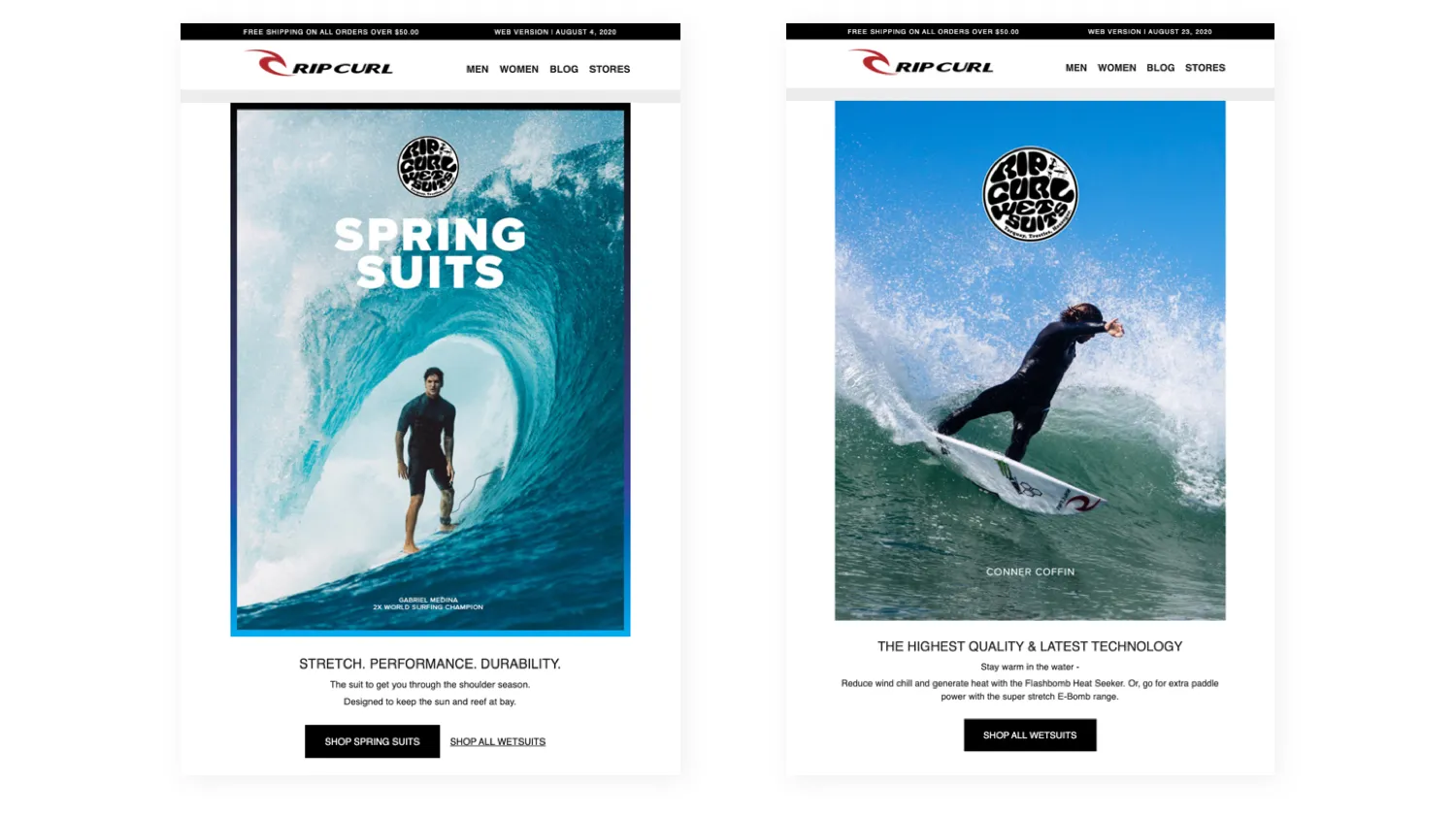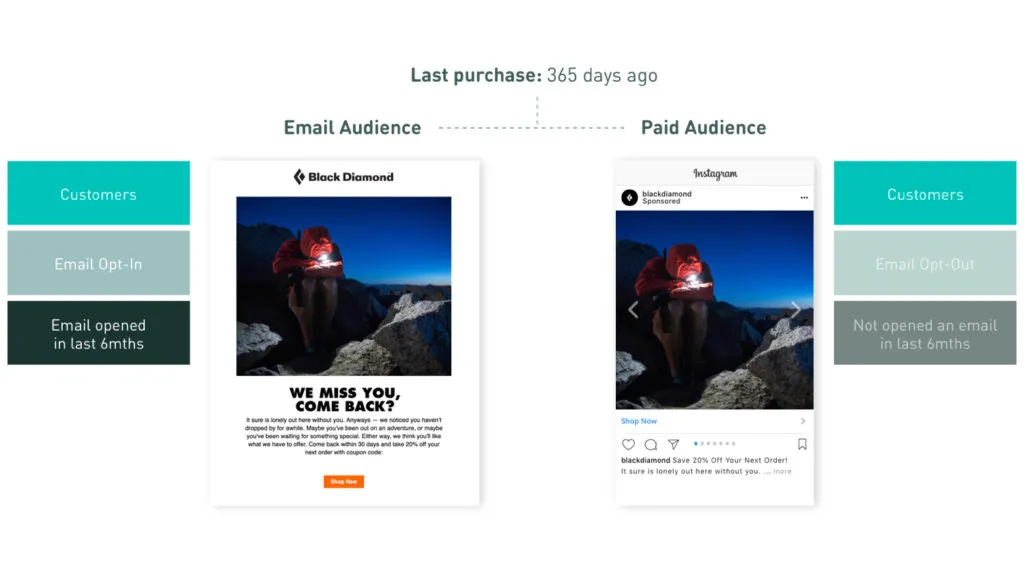October 23, 2020
The end-to-end guide to lifecycle targeting for outdoor brands
What do outdoor brands like Spyder, Mountain Khakis, Rip Curl, and Black Diamond have in common? They’ve all successfully implemented data-driven engagement strategies across every lifecycle stage. Here’s our complete guide to high-impact customer lifecycle targeting for outdoor brands and retailers.

According to McKinsey, U.S. ecommerce activity saw 10 years worth of growth in the first 90 days of the COVID-19 pandemic.
To keep up with this accelerated pace of change, leading brands and retailers are adapting their approach to customer engagement. By bringing all of their data sources together to achieve a single view of the customer and then enriching that view with predictive analytics and third-party data, brands have been able to unlock meaningful insights that inform personalized, omnichannel customer experiences.
This focus on data is particularly valuable for outdoor and sports brands. As Lexer’s largest customer segment, outdoor and sports brands sell primarily functional products, which lend themselves well to effective and impactful personalization strategies for acquisition, growth, and retention.
For example, using the Lexer Customer Data Platform (CDP):
- Spyder grew their email list by 85% in 5 months.
- Mountain Khakis boosted Black Friday sales 49% year-over-year.
- Rip Curl improved revenue from a cross-selling campaign by 15x.
- Black Diamond increased retention email conversion rates by 555%
Using these examples from outdoor brands, this playbook will delineate our end-to-end engagement strategies across every stage of the customer lifecycle, from prospecting to retention.
High-performance prospecting with persona-driven sweepstakes
1. Find your highest-value customers.
For most modern DTC businesses, the top 20 percent of customers make up the majority (about 50 to 90 percent) of profit. This disparity in customer value is known as the Pareto Principle.
When skiing brand Spyder implemented the Lexer CDP, they found that the value distribution across their customer base followed the Pareto Principle almost perfectly, with 20 percent of their customers making up 81 percent of their revenue. Diving further into their highest value customers revealed that the top 5 percent made up 67 percent of their sales.
The first step to high-performance prospecting and acquisition is to identify these high-value customers and build lookalike audiences around them. Because these customers are likely to have high profitability over their lifetimes, this strategy can have a transformative impact on customer growth and value.
And the best part? Your business doesn’t have to be massive to create high-value lookalike audiences. The minimum size for custom audiences in Facebook is 1,000 people, so any business with 4,000-5,000 customers in their database can start driving the needle with lookalikes of their top 1,000 customers.
2. Develop simple persona segments based on these high-value customers.
All too often, we see brands trying to make persona segmentation very granular and comprehensive—but if you can’t link those personas to each customer in your database, they’ll be next to impossible to use for practical targeting.
So, start simple. Look at the top 20 percent of your customers and their past purchases to infer their key buying motivations.
For example, Spyder used the Lexer CDP to identify three core persona segments within their high-value customers:
- Families: These customers are parents who frequently buy children’s wear. The high frequency of purchases, as well as the large basket sizes, is what makes this segment so high-value.
- Brand Loyalists: These customers make frequent purchases of mid to low-value items. After looking at the location of these customers, we learned that they tend to live close to popular ski destinations and are likely to go skiing multiple times per season.
- Affluent Off-Mountain: These customers are one-time buyers of premium products. Because these customers live in major cities, we can infer that they’re holiday-based skiers who fly to the mountain.
Once you’ve created simple persona segments like these, matching creative to the buying motivation of each segment becomes fairly intuitive.
3. Run sweepstakes campaigns that appeal to the buying motivations of each persona segment.
After identifying the buying motivations of your high-value customer personas, use those insights to inform the creative, messaging, and offers of your prospecting campaigns.
Sweepstakes are incredibly effective for this. By serving ads to high-value lookalike audiences that encourage email sign-ups for the chance to win a relevant offer—for example, new skiing outfits for the whole family for the Families persona segment—you give new prospects the incentive to opt-in for future nurturing via email.
Here’s how we matched each persona to relevant creative for Spyder’s targeted prospecting campaigns:

These campaigns ran over a 5-month period and were incredibly successful, driving:
- An 85 percent growth in Spyder’s email database.
- A 94 percent increase in revenue for promotional emails.
- A 52 percent increase in revenue for content-focused emails.
Notably, these campaigns had a 0.5-1 return-on-ad spend (ROAS) at only a $0.30–$0.90 cost-per-acquisition (CPA). Although the objective of these campaigns was only to grow the database, we also drove a small number of conversions that nearly funded the entire cost of the campaigns.
How did we accomplish this?
4. Direct subscribers to a relevant product page after they’ve signed up.
This last step is the most important.
Although prospecting campaigns aren’t typically associated with an immediate return on investment, directing prospects to the product page relating to the offer can drive a small but impactful number of conversions. This strategy is an often-missed opportunity to improve the efficiency and impact of your prospecting efforts.
In particular, be sure to send an email to entrants immediately after they enter, thanking them for joining the competition and encouraging them to visit your site. This point of contact offers an additional opportunity for them to convert and primes them for continued email engagement while your brand is still fresh in their minds.
Once you’ve built a robust and engaged prospect list, it’s time to start targeting those prospects for acquisition.
High-value customer acquisition with simple segmentation
1. Develop simple, high-value customer segments for testing and paid media.
As with prospecting, focusing your acquisition efforts on high-value, high-quality audiences will drive the best results.
Once you’ve identified your highest-value customers, use customer segmentation tools to create simple segments that aid in your personalization efforts.
For example, after implementing the Lexer CDP for outdoor apparel retailer Mountain Khakis, we recommended that they start by segmenting their high-value customers by gender and recency.
Gender and recency are simple, straightforward variables that can have a massive impact on the performance of your campaigns. Segmenting by gender enables quick and easy ad personalization even for brands with very little customer data to work with, while segmenting by recency allows you to understand performance differences in active vs. inactive customers.
Typically, we recommend that brands add gender as a field for email sign-ups and surveys to make segmenting by gender as easy as possible. However, if you’re not capturing your customers’ gender, the Lexer CDP uses a gender inference model based on customers’ first names to accurately infer gender for about 65 percent of your database.
2. Personalize your ad creative to each audience.
After creating your segments, use the insights you have on each segment to personalize your ad creative, messaging, and offer.
For example, Mountain Khakis used its high-value male audience and its high-value female audience to create holiday-based ads to drive revenue and acquisition. Featuring flat lays of men’s products and women’s products, they offered free shipping to encourage digital sales during the holiday season:

This simple tactic of segmenting audiences by lifetime value and gender and personalizing advertising accordingly created a significant uplift for Mountain Khakis running into the holidays. On Black Friday, they saw:
- A 47 percent increase in customers transacting as compared to the prior year.
- A 49 percent increase in revenue as compared to the prior year.
This year-over-year growth in transactions and revenue was seen for both new and returning customers, meaning that the campaign served as an effective retention strategy as well as an acquisition driver.
3. Use the post-campaign analysis to discover more actionable insights.
One of the major benefits of using data to inform acquisition audiences, messaging, and strategies is that it provides a benchmark for pre-and post-campaign performance. By digging into your customer data following the campaign, you can discover additional insights about your newly-acquired customers that help you optimize your future performance.
For Mountain Khakis, we looked at the gender distribution of the customers acquired during their insight-driven holiday campaign and found that the number of new female customers was significantly higher than in previous periods:

A large number of these female customers had purchased men’s products, which is a clear sign of gifting. This real-time insight enabled Mountain Khakis to be incredibly agile in their response, creating an audience of female customers who’d purchased men’s products and retargeting them with an ad contextualized to their gifting motivation:

This campaign drove a second purchase from newly-acquired customers two to three weeks after their first purchase, resulting in a 7.1x ROAS. Because one-time buyers are almost always the largest segment by volume for direct-to-consumer brands, this ability to drive the elusive second order within weeks of the first was a truly remarkable win for Mountain Khakis.
As ecommerce continues to grow, pay close attention to the profile and behaviors of newly acquired customers and use this customer insight to pivot your acquisition and growth strategies as needed.
Growing CLV with personalized email programs
1. Unify your data to create a single view of the customer.
Disparate data is one of the most common obstacles to personalized lifecycle targeting.
This challenge is what led surfing brand Rip Curl to Lexer. Prior to implementing the Lexer CDP, they used a number of different systems to manage different business functions, and none of their data sources were connected. This disconnect between retail and ecommerce data made it impossible to understand the true lifetime value of their omnichannel customers.
By implementing the Lexer CDP, Rip Curl was able to embed a unique Rip Curl ID to stitch together their customer data across all systems, creating an actionable profile for every individual customer. These individual profiles provide insights into customer’s interests and behaviors, including their surfing activity tracked using Rip Curl’s SearchGPS watch.
For more information on measuring lifetime value and customer profitability across channels, click here to read “5 Omnichannel Metrics Every Customer-First Brand Should Measure.”
2. Build customer segments based on past products purchased.
For outdoor brands and retailers, one of the simplest email personalization strategies is to segment audiences by the functional products they’ve purchased.
For example, Rip Curl used product data to create segments of customers who’ve previously bought wetsuits, functional surfing products, or the SearchGPS watch. Based on this past purchasing data, the Rip Curl team could assume that each of these segments was interested in surfing and build a campaign relevant to their interests.
As a side benefit, creating targeted email audiences and suppressing irrelevant or uninterested audiences leads to major improvements in delivery scores and reduces the risk of messaging fatigue.
3. Send targeted emails based on these segments’ interests and past purchases.
After inferring customer interests by transactional behavior, create email content targeting these interests and send them to these audiences.
For example, here are the surfing-based emails that Rip Curl created after segmenting customers by past purchases and SearchGPS data:

This segmentation strategy is relatively simple, but it drives significant increases in conversion rates.
For Rip Curl, the emails sent to Lexer-powered surfing and wetsuit segments drove:
- 93 percent more revenue per campaign in the first month.
- 15 times higher revenue than previous email campaigns.
Additionally, Rip Curl used CDP-powered segments, automated journeys, and marketing campaigns to roll out their global wetsuit product. As Rip Curl’s biggest digital product rollout ever, this campaign led to key sizes of premium products selling out in just three weeks.
Automated retention journeys across social and email
1. Segment lapsed customers by channel addressability.
In our work with outdoor brands and retailers, we’ve found that it’s common for less than one-third of lapsed customers to be addressable via email. If you’re using email as your predominant retention channel, then you could be missing the opportunity to re-engage two-thirds of your lapsed customer base.
Therefore, the most effective retention strategy targets lapsed customers across channels to increase reach. After identifying your lapsed customer base, segment them into two audiences: Those who’ve opted out of or disengaged from email and those who are still opted in and engaged with email.
2. Target lapsed customers across social and email to increase reach.
Once you’ve segmented your lapsed customers by channel addressability, develop targeted ads to re-engage them across email and paid media.
For example, climbing, skiing, and running equipment brand Black Diamond sent the following ads to opted-in customers via email and opted-out customers via paid social:

These ads are more likely to re-engage lapsed customers not only because they’re reaching customers through the channels they’re actually paying attention to, but also because of the quality of their creative and messaging. With an in-depth understanding of who their customers are, what they value, and why they buy, Black Diamond is able to reflect those values in their ad copy to genuinely connect with its audience.
And it worked. This campaign resulted in:
- A 555 percent increase in email conversion rates.
- A 1101 percent increase in revenue per email.
- A 4.48 ROAS for paid social.
3. Automate your retention campaigns to re-engage customers at the optimal moment.
Finally, set up your automated retention journeys to trigger as soon as the customer fulfills the audience requirements.
For example, Black Diamond’s omnichannel retention campaigns have been set up using the Lexer platform to trigger as customers near the 365-day mark following their last purchase.
By automating your re-engagement journeys, you can target customers at the right time, through the right channel, to promote retention and grow customer lifetime value.
Key takeaways: Using data for prospecting, acquisition, growth, and retention
For outdoor brands and retailers, the key to genuinely engaging customers and driving profitable growth across every lifecycle stage is as follows:
- Prospecting: Focus on the buying motivations of your high-CLV customers.
- Acquisition: Incorporate gender into your high-value lookalike audiences to personalize creative.
- Growth: Segment your customers by past products purchased to improve email relevance.
- Retention: Target your opted-out and email non-openers in paid media to increase reach.
Outdoor brands and retailers can implement these straightforward strategies with ease using the Lexer CDP. Whether you’re operating with a small number of owned channels like email, social and SMS or you have a complex customer engagement ecosystem that spans channels and datasets, our CDP can help you grow revenue, reduce costs, and deliver truly personalized and engaging customer experiences across every lifecycle stage. Combined with strategic guidance and technical support from our success team, the Lexer CDP has helped some of the world’s most iconic brands transform into data-driven, customer-centric businesses.
Interested in CDP-powered lifecycle targeting for your outdoor brand? Use the calendar below to book a demo and see how the Lexer platform can help you.
Speak with our retail experts

